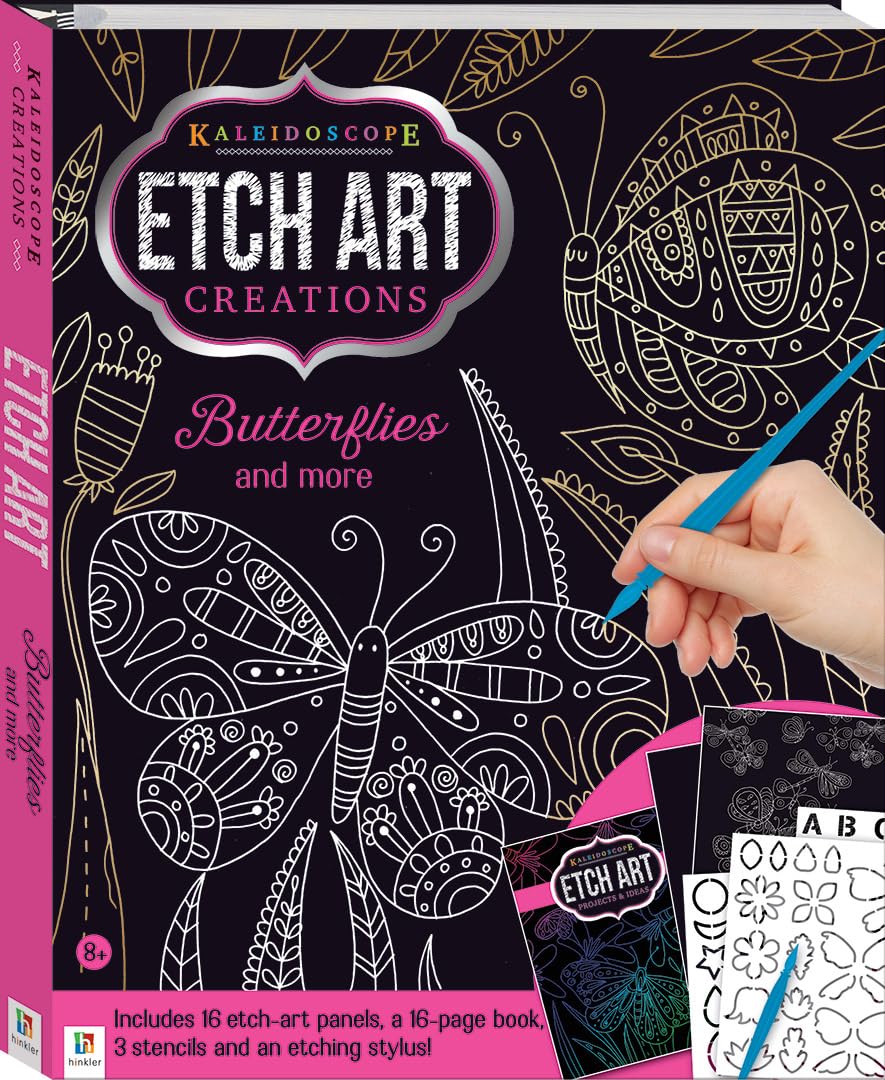
Kaleidoscope Etch Art Creations: Butterflies and More
FREE Shipping
Kaleidoscope Etch Art Creations: Butterflies and More
- Brand: Unbranded

Description
Draw on the etch-art panels with the stylus to uncover the bright foil or patterns underneath, making your creations burst with life!
Cohen, Brian D. "Freedom and Resistance in the Act of Engraving (or, Why Dürer Gave up on Etching)," Art in Print Vol. 7 No. 3 (September–October 2017), 17. The switch to copper plates was probably made in Italy, [14] and thereafter etching soon came to challenge engraving as the most popular medium for artists in printmaking. Its great advantage was that, unlike engraving where the difficult technique for using the burin requires special skill in metalworking, the basic technique for creating the image on the plate in etching is relatively easy to learn for an artist trained in drawing. On the other hand, the handling of the ground and acid need skill and experience, and are not without health and safety risks, as well as the risk of a ruined plate. A waxy acid-resist, known as a ground, is applied to a metal plate, most often copper or zinc but steel plate is another medium with different qualities. There are two common types of ground: hard ground and soft ground.Etching is also used in the manufacturing of printed circuit boards and semiconductor devices, and in the preparation of metallic specimens for microscopic observation.
Jacques Callot (1592–1635) from Nancy in Lorraine (now part of France) made important technical advances in etching technique. Traditional intaglio printmaking methods, their health hazards, new non-toxic substitutes". Greenart.info. 2013-03-14 . Retrieved 2015-08-11. Soft-ground etching uses a special softer ground. The artist places a piece of paper (or cloth etc. in modern uses) over the ground and draws on it. The print resembles a drawing. Soft ground can also be used to capture the texture or pattern of fabrics or furs pressed into the soft surface. Billard, Jules B. (1989). "Jess D. Jennings, "Across an Arctic Bridge" ". The World of the American Indian, A volume in the Story of Man Library. Washington D.C.: National Geographic Society. p.47. ISBN 0870447998.
Creative Play
It was a complex and involved process, but it did allow artists to craft and mass-produce prints of staggering clarity and quality.
Self Portrait in a Flat Cap and Embroidered Dress” (c. 1638), Rembrandt van Rijn. Etching on laid paper with small margins. The process as applied to printmaking is believed to have been invented by Daniel Hopfer ( c. 1470–1536) of Augsburg, Germany. Hopfer was a craftsman who decorated armour in this way, and applied the method to printmaking, using iron plates (many of which still exist). Apart from his prints, there are two proven examples of his work on armour: a shield from 1536 now in the Real Armeria of Madrid and a sword in the Germanisches Nationalmuseum of Nuremberg. An Augsburg horse armour in the German Historical Museum, Berlin, dating to between 1512 and 1515, is decorated with motifs from Hopfer's etchings and woodcuts, but this is no evidence that Hopfer himself worked on it, as his decorative prints were largely produced as patterns for other craftsmen in various media. The oldest dated etching is by Albrecht Dürer in 1515, although he returned to engraving after six etchings instead of developing the craft. [13] Our collection Artists Artworks Art by theme Explore Videos Podcasts Short articles In depth Art Terms Tate Research Student resources Make art Create like an artist Kids art activities Tate Draw game With that in mind, we’ve put together this beginner’s introduction to etching, showing how artistic etchings are made. Our etching guide is illustrated by some visual aids we recorded while visiting Amsterdam’s remarkable Rembrandt House Museum a few years ago.
More in Offers
Peter Farb, Man's Rise to Civilization (1978) p.205, citing Emil Walter Haury, The Hohokam: Desert Farmers and Craftsmen (1976) oil/tar based asphaltum [18] or bitumen as hard ground, although often bitumen is used to protect steel plates from rust and copper plates from aging.
- Fruugo ID: 258392218-563234582
- EAN: 764486781913
-
Sold by: Fruugo
